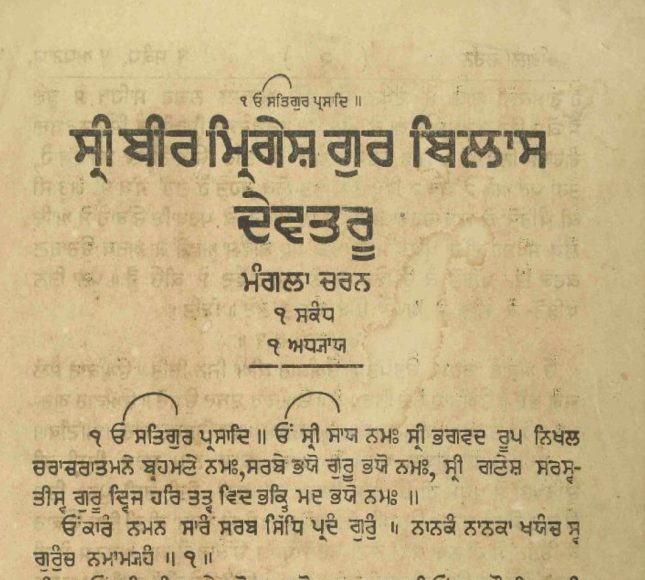BIR MRIGESH, full title SRI BIR MRIGESH GURBILAS DEV TARU, is a voluminous nineteenth century work by Bhai Sher Singh, a disciple of Baba Khuda Singh (1786-1861), who completed it in 1911. In bold Gurmukhi typography, the book runs to 1912 pages, divided into two parts comprising 847 and 1065 pages, respectively. It contains accounts, in ample detail, of the lives of Baba Sahib Singh Bedi, Baba Bhag Singh of Kuri, Baba Bir Singh of Naurangabad and Baba Khuda Singh. The author refers to these luminaries as guru and calls his book gurbilas (biography of the Gurus).
The phrase Dev Taru added to title literally means godly tree and accordingly its subparts are called skandhs (branches). Skand Asare further subdivided into adhyayas (chapters). The first part called Purvardh, lit. earlier half, contains two skandhs and 61 adhyayas while Part II, Uttarardh, lit. the latter half, has three skandhs and 84 adhyayas. The author describes the four holy men as spiritual adepts of the highest rank, and revels in a detailed exposition of their views. The language the author uses is sadhukan, a dialect common among the sadhus, and the style is anecdotal.
Historical Context and Authorship
Sri Bir Mrigesh GurBilas Dev Taru is a monumental work composed by Bhai Sher Singh, a learned Nirmala scholar and a devoted disciple of Baba Khuda Singh (1786–1861). Completed in 1911, this expansive gurbilas occupies 1912 pages and reflects the intellectual and devotional fervor of its time. Though built on traditional oral histories and earlier written sources, its scope and detailed narrative mark it as a significant achievement in the late 19th–early 20th century Sikh literary revival.
Structure and Organization
The work is designed with a deliberate structural complexity:
Two Major Parts:
Purvardh (the earlier half) comprises 847 pages.
Uttarardh (the latter half) spans 1065 pages.
Subdivisions:
Each part is divided into sections called skandhs (branches), which are further subdivided into adhyayas (chapters). In Purvardh, there are two skandhs with a total of 61 chapters, while Uttarardh includes three skandhs encompassing 84 chapters.
The title itself—where Dev Taru translates to “godly tree”—suggests that the work is meant to be a living repository branching out into various narratives and teachings, much like the luxuriant branches of a sacred tree nurturing its devotees.
Content: Lives of the Holy Luminaries
At its heart, Sri Bir Mrigesh is a richly detailed biography in the tradition of a gurbilas—a genre dedicated to recounting the lives and spiritual exploits of Sikh Gurus and eminent figures. Specifically, the work contains extensive accounts of:
Baba Sahib Singh Bedi:
His life and spiritual journey are chronicled with an emphasis on his exemplary devotion and teacherly wisdom.
Baba Bhag Singh of Kuri:
Detailing his contributions and the transformative impact of his teachings within the Sikh tradition.
Baba Bir Singh of Naurangabad:
Whose narrative not only inspires through his personal piety but also through the embodiment of heroic spiritual ideals.
Baba Khuda Singh:
A central figure whose legacy is interwoven through profound philosophical insights and steadfast adherence to the Sikh way of life.
Bhai Sher Singh uses a dialect known as sadhukan—the language common among sadhus—which infuses the text with an anecdotal and earthy tone. This stylistic choice not only makes the biography intimate and engaging but also preserves the oral flavor of Sikh spiritual lore.
Spiritual and Literary Significance
Devotional Veneration and Historical Record:
Sri Bir Mrigesh stands as more than a mere historical chronicle; it is a devotional homage to a set of spiritual adepts regarded by the author as embodiments of the Sikh spirit. By recording their lives in lavish detail, the work provides insights into the ethical, mystical, and social dimensions of these figures—serving as both a source of inspiration and a reference for scholars.
Anecdotal Style and Exposition:
The narrative is rich with personal anecdotes, vivid descriptions, and theological reflections. This blend of hagiography and history makes it a key work for understanding how Sikh communities in that era sought to preserve and celebrate their cultural memory against the backdrop of rapid social and political change.
Legacy in Sikh Historiography:
Having influenced subsequent generations of researchers and devotees, Sri Bir Mrigesh continues to be consulted not only for its historical content but also for its literary qualities. It exemplifies the tradition of gurbilas texts which serve to both document and mythologize the lives of the sacred figures, ensuring that their lessons and legacies endure both as academic subjects and as living sources of faith.



